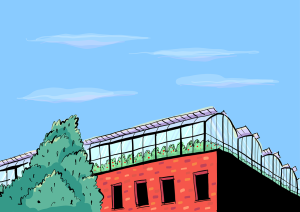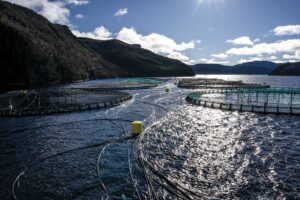
Travel
How to stop a gold rush
The new movement building flourishing tourism hubs across Canada – one sustainable example at a time
- 3297 words
- 14 minutes
Travel
Wine, cheese and all the rest: highlights from Quebec’s sustainable culinary industry

At the end of summer, the countryside of southern Quebec is painted with rolling fields and farmlands, green bushes of berries and herds of cows and sheep grazing under a big blue sky. This part of the country can also lay claim to arguably the finest selection of farm-to-table producers and restaurants in Canada, a testament to just how enthusiastically locals have adopted this philosophy of sustainable cuisine. On a memorable culinary tour of the region in early September, I tasted an exceptional variety of local cheeses, wines, vegetables, meats and more, all described in detail below.

Quebec has a well-earned reputation for exporting excellent cheeses, and the Fromagerie du Presbytère in Sainte-Élizabeth de Warwick is one of its finest small producers. Jean Morin, the owner, is a fourth-generation dairy farmer who grew up across the street from the church and presbytery, which now house the Fromagerie’s production facilities and storerooms. The cows, which provide the milk for his cheeses, still live across the road. All of their products are superb, especially the award-winning Louis d’Or cheese, which has a full, nutty flavour. Their most prominent attraction, however, is their fresh cheese curds, offered only on Fridays. Cheese curds are a popular treat in Quebec that can be found in a bag at most grocery stores, but good ones are highly coveted. As a key ingredient in poutine, a national delicacy, cheese curds from the Fromagerie du Presbytère are not to be missed. Jean tells us the previous Friday, between four to 5,000 people flocked to this little town of not quite 400, all for the curds.
Another noteworthy stop for cheese is the Abbaye de Saint-Benoît-du-Lac, located in the Eastern Townships at the head of Lake Memphremagog. This small community of Benedictine monks has been making cheese since 1943, both for their own consumption and to sell to visitors in the gift shop. They also manufacture their own cider, using apples from the Abbey’s orchard, as well as fruit compotes and spreads. Fun fact: the monks here produced Canada’s first-ever blue cheese, the Ermite, which they still sell. The old stone Abbey itself is well worth a visit for any folks seeking quiet respite during their travels. Locals often come to sit through mass, which occurs daily, as monks play the organ and sing in Gregorian and Latin chants.

Boasting hundreds of skilled “fromagers,” Quebec has a reputation for fine cheeses but remains an underrated producer of quality wines. In the very south of the province, near the township of Dunham, is the Vignoble du Ruisseau, a first-rate destination for wine tasting. The vineyards here are the only ones in Quebec to use exclusively European grapes. The Vignoble bottles Pinot Noir, Merlot, Cabernet-Sauvignon, Chardonnay, Riesling, and Gewürztraminer. Visitors can also dine at the Vignoble’s bistro, which offers a picturesque view of the vineyards and surrounding hills. Our guide tells us that 65 per cent of the ingredients in dishes served at the bistro come from land owned by the Vignoble, which raises its own cows and pigs, as well as a variety of fruits and vegetables. While wine-tasting, we munch on fresh ham, purple and orange beets, and sweet, explode-in-your-mouth tomatoes.
In addition to top-notch producers, this region of Quebec also promises a selection of excellent restaurants. Le Coureur des Bois, in Beloeil (on the Richelieu River, about a half-hour drive east of Montreal), is one of the many that sources most of their ingredients from local farmers. Consequently, their menu is seasonal and flexible – I learn just how flexible when chef de cuisine Éric Fortin tells us that the grilled tuna in our entrée comes from a 565 lb Bluefin which he caught off the coast of the Gaspé Peninsula, shortly before our visit. It is spectacular. And just as impressive as their food is the selection of wines. Their remarkable inventory of over 14,000 bottles has earned them the Grand Award of Excellence from Wine Spectator for five years running. Visitors to the restaurant can sample a wine pairing from a collection of local and international bottles with each course. We tasted a bottle of Castor, a semi-dry white wine from the Vignoble Les Gémeaux in Hinchinbrooke, Quebec, which I found to be superb and full of fruity notes.

We end our tour in Montreal, a global reference point for world-class cuisine. Even in the city, the farm-to-table movement is going strong, with restaurants tapping into the network of nearby producers to procure high-quality ingredients. This is how it’s done at the Restaurant de l’ITHQ, situated on Saint-Denis Street across from the charming and historic Square Saint-Louis. The restaurant’s building also houses Quebec’s premier culinary school, the ITHQ school, on its upper floors. Students in the last year of their degrees here are given a chance to gain practical experience in the Restaurant’s kitchen under the supervision of veteran chefs. The menu is seasonal and often informed by what ingredients students currently use in their classes. I am delighted to see cheese from the Fromagerie du Presbytère listed among the Restaurant’s dessert offerings, a farm-to-table connection I can now trace. Our group opts for the six-course tasting menu with wine pairings – it is outstanding, and every dish is beautifully plated. My favourite appetizer is the ceviche, with scallops from the Gaspé. It is served with fresh strawberries and is both deliciously salty and refreshing. For dessert, we enjoy cheese with fresh honeycomb. As I sit, stuffed, watching people walk through the Square Saint-Louis, I reflect on the countryside we drove through before arriving in Montreal. It is splendid and soul-nourishing, just like the food it produces.
Are you passionate about Canadian geography?
You can support Canadian Geographic in 3 ways:

Travel
The new movement building flourishing tourism hubs across Canada – one sustainable example at a time

Environment
Already gaining steam before the pandemic, interest in urban farming — and hunger for hyper-local food — has soared. A look at three Canadian takes on the urban farming phenomenon

Travel
Un nouveau mouvement créateur de pôles touristiques florissants dans tout le Canada – la durabilité, un exemple à la fois

Environment
Struggle and success in Atlantic Canada, where aquaculturists strive to overcome climate change and contamination while chasing a sustainable carbon footprint